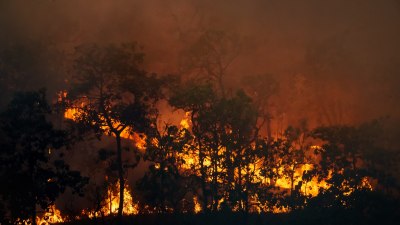Why Thunderstorms Can Trigger Wildfires
Explore how thunderstorms can lead to the ignition and spread of wildfires in various climates.

Thunderstorms are a spectacular display of nature's power, but they can also pose significant risks, particularly in areas prone to wildfires. Understanding the mechanisms by which thunderstorms can trigger wildfires is crucial for effective risk management, preparedness, and fire prevention strategies.
One of the primary ways thunderstorms contribute to wildfire ignition is through lightning strikes. Lightning is a frequent companion of thunderstorms, and it can strike dry vegetation, igniting it in the right conditions. The average temperature of a lightning strike can exceed 30,000 degrees Fahrenheit, far exceeding the ignition temperature of most forest materials. When a lightning bolt strikes a tree or dry brush, the intense heat can ignite the surrounding area, especially if the vegetation is parched due to drought conditions.
The Role of Drought
Many regions face periodic drought, which dries out grasses, shrubs, and trees. When thunderstorms occur during or after such dry spells, the ignition potential of lightning strikes increases significantly. Drought-stricken environments are characterized by low moisture content in the vegetation, which enables fires to ignite and spread rapidly. Furthermore, after long periods of dryness, rain brought by thunderstorms can also contribute to an explosion of growth in vegetation, often referred to as a 'green-up.' This new growth can then dry out, increasing the fuel load for potential wildfires later in the season.
Dry Thunderstorms
Not all thunderstorms result in heavy rain. In many cases, thunderstorms can be classified as dry thunderstorms, which produce lightning but little to no precipitation. The lack of rainfall can lead to dry lightning strikes that ignite fires without the benefit of moisture to dampen the landscape. Dry thunderstorms are particularly hazardous, as they occur in already vulnerable ecosystems and can lead to rapid fire events that catch communities off guard.
Dry lightning is one of the major causes of wildfires in certain regions, including the intermountain West of the United States. The atmospheric conditions necessary for the formation of dry thunderstorms typically include warm air, low humidity, and sufficient upward motion to generate thunderstorms. These conditions are particularly prevalent during the summer months when the risks of wildfire outbreaks are at their peak.
Wind Dynamics
An additional factor that contributes to the wildfire risk associated with thunderstorms is the wind dynamics that accompany them. Thunderstorms are often accompanied by gusty winds, which can exacerbate fire spread once a fire starts. Winds can carry embers and flames to new, unburned areas, creating spot fires well ahead of the main fire front. In extreme cases, fierce winds can create firestorms capable of consuming entire landscapes.
Moreover, when thunderstorms develop into severe storms or supercells, the wind can be remarkably strong. These powerful winds can uproot trees, snap power lines, and create flying debris, all of which can serve as ignition sources or contribute to the fire's spread.
The Fire Triangle
To understand the conditions necessary for a wildfire to ignite and sustain itself, we can refer to the concept of the fire triangle. The triangle consists of three elements: heat, fuel, and oxygen. Thunderstorms provide the heat necessary for ignition through lightning strikes, while drought and subsequent green-ups provide the abundant fuel. In addition, various ecosystems have a sufficient amount of oxygen for fire propagation due to the epiphytes, grasses, and other organic materials found within that environment.
The interaction of these elements creates a perfect storm for wildfires. Thunderstorms not only supply the heat from lightning but also alter the atmospheric conditions to favor fire spread, resulting in increases in humidity and changing wind patterns which can aid a fire's growth.
Historical Context
Throughout history, there have been numerous notable wildfires sparked by thunderstorms. Regions like California have recorded devastating wildfires, many of which were initiated by dry lightning strikes during summer thunderstorms. The infamous 'Big Burn' in 1910, which consumed over three million acres in Idaho and Montana, was significantly influenced by thunderstorms that delivered dry lightning. More recent fires, such as the 2020 California wildfires, showcase how thunderstorms can reignite dormant fires or start new ones, propelling them quickly across the remote landscapes of the western United States.
Understanding the historical context helps clarify the importance of monitoring thunderstorms as part of wildfire risk management. Many firefighting agencies adjust their resources and readiness levels in anticipation of potential thunderstorm activity recognized for its high correlation with increased fire incidents.
Wildfire Predictions and Monitoring
Advancements in technology have paved the way for improved wildfire prediction and monitoring strategies. Satellite technology and remote sensing are widely used to detect thunderstorms, lightning strikes, and environmental conditions conducive to fire growth. The National Oceanic and Atmospheric Administration (NOAA) and the National Interagency Fire Center (NIFC) collaborate to provide timely weather updates that help identify areas at risk of wildfires from thunderstorms.
Monitoring lightning activity is crucial for determining when crews need to be on alert and ready to respond if a fire breaks out. Firefighters often use ground weather stations to track various meteorological factors, including humidity levels, temperature fluctuations, and wind patterns, which are useful in predicting when thunderstorms and subsequent fire events may occur.
Community Preparedness
Effective wildfire management relies on community preparedness as much as on firefighting resources. Communities located in areas susceptible to wildfires should develop robust preparedness plans that consider the threat presented by thunderstorms. This may include establishing clear evacuation routes, creating defensible spaces around properties, and ensuring residents have access to timely information on weather alerts.
Individuals should also stay informed about local wildfire risks, especially during the summer months when thunderstorms are more prevalent. Engaging in community drills and participating in local fire prevention programs can reduce risks associated with wildfires triggered by thunderstorms. Creating awareness in schools, workplaces, and public forums will foster a culture of safety and make individuals more prepared to react effectively when wildfires threaten their area.
In conclusion, thunderstorms can trigger wildfires through various mechanisms, including lightning strikes, dry conditions, and subsequent wind patterns. Recognizing the correlation between these atmospheric events and wildfire risks is essential for effective management and mitigation strategies. With proper monitoring, community engagement, and resource allocation, jurisdictions can better protect lives and property from the destructive nature of wildfires. Emphasizing the importance of awareness can significantly enhance preparedness in regions prone to both thunderstorms and wildfires. As environmental conditions continue to evolve, understanding these relationships will remain critical in safeguarding our communities.











